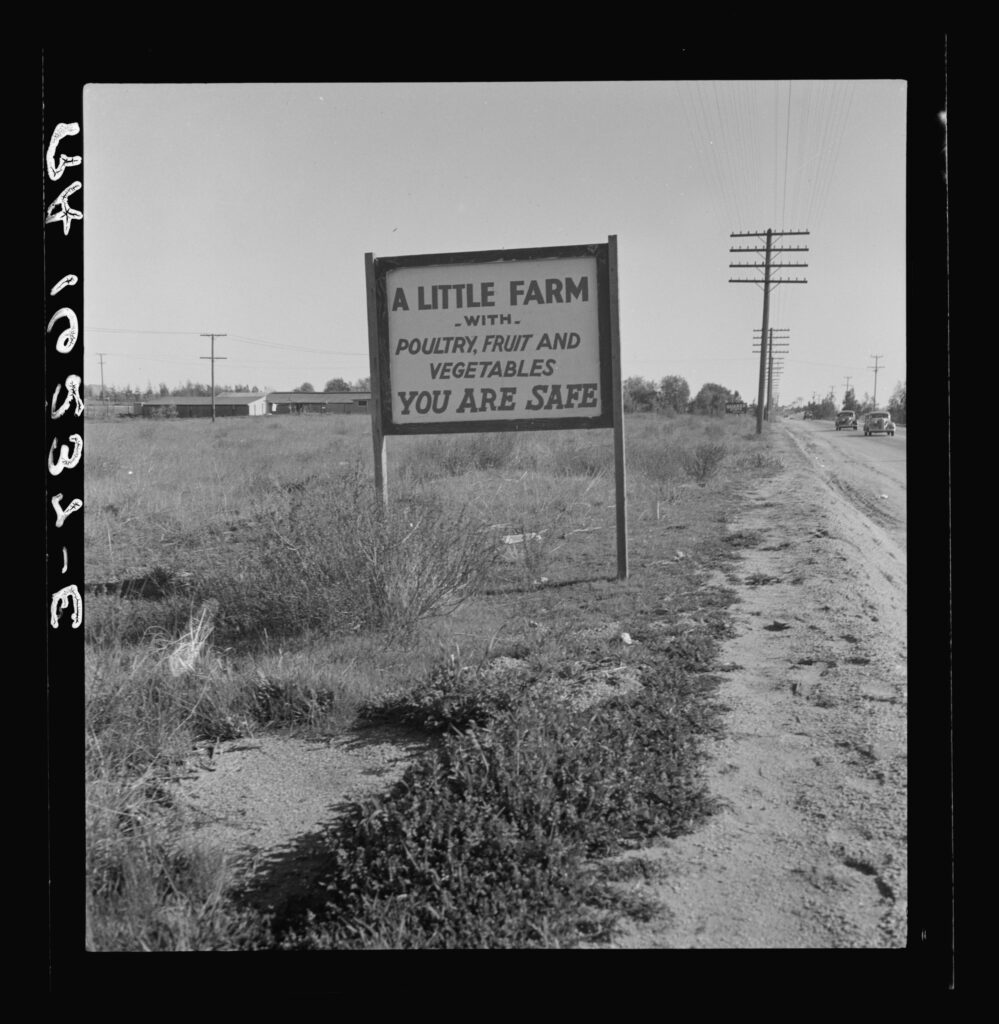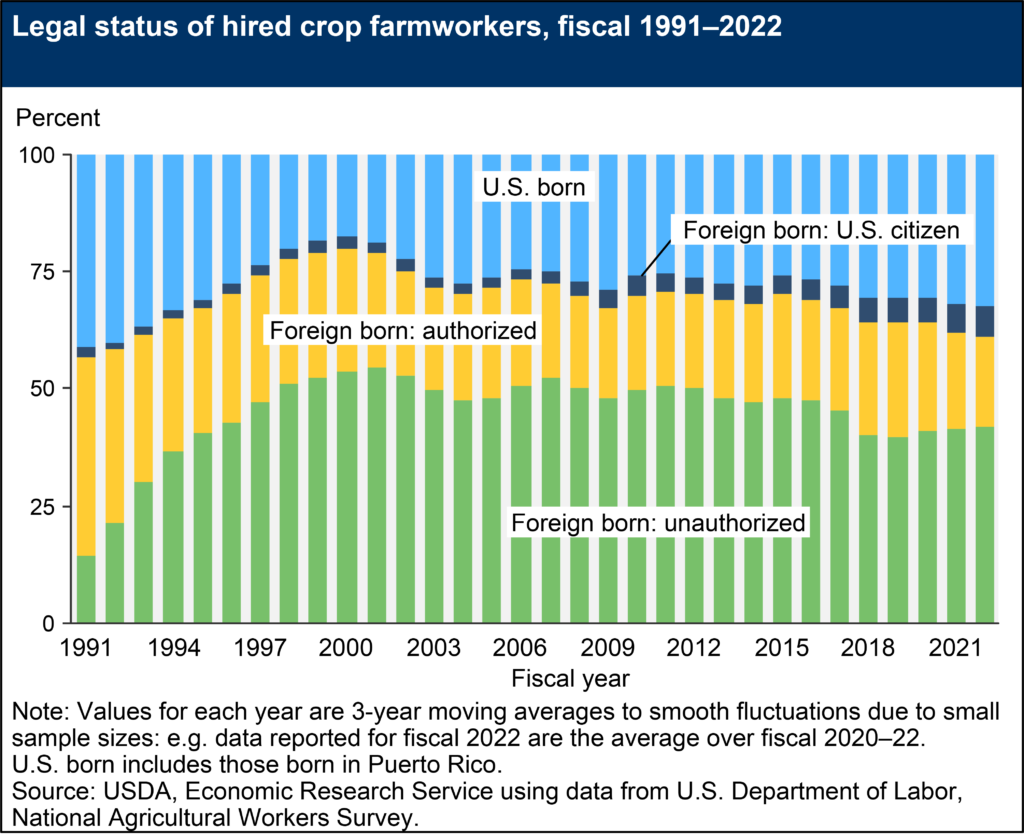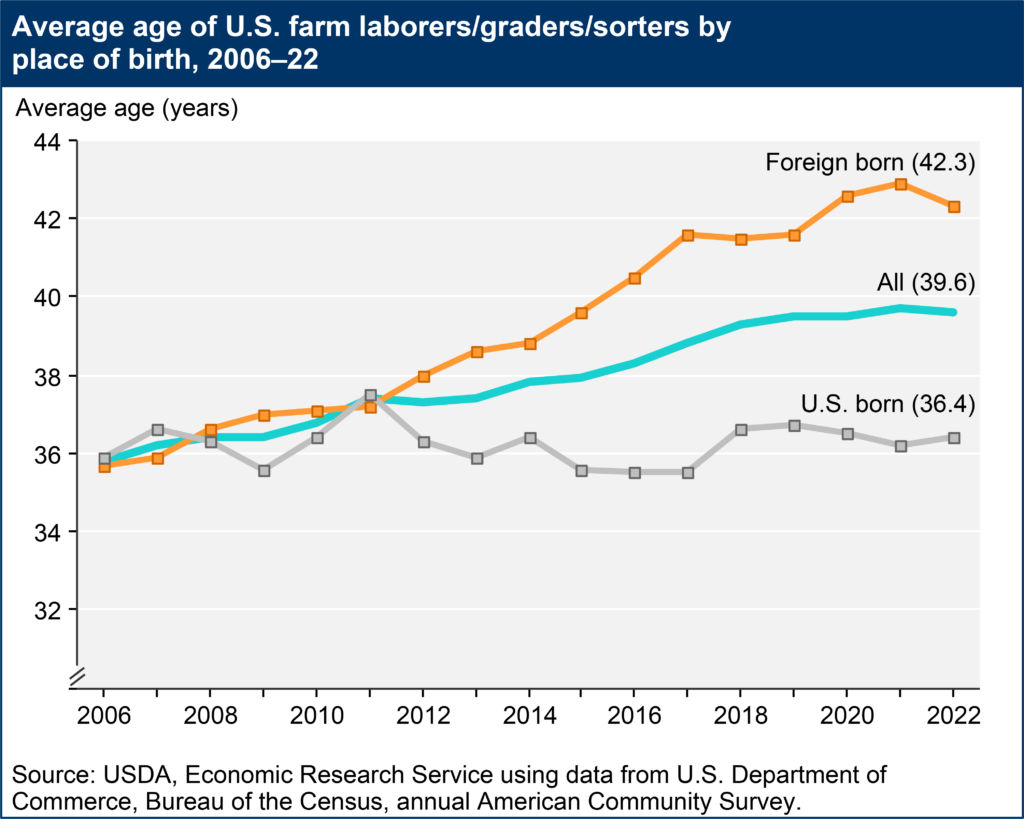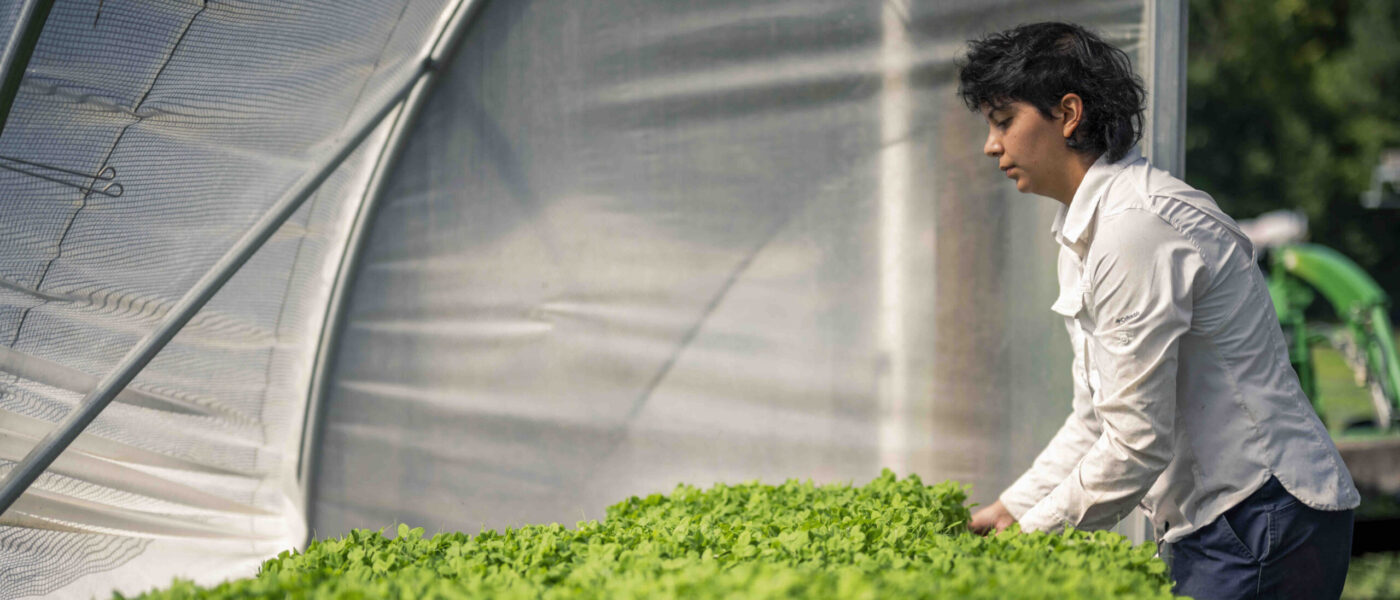Immigrants–whether migrants from other countries here temporarily for work, people who have become U.S. citizens after leaving their home country, or immigrants to the U.S. who are not authorized–are deeply involved in the complex journey our food takes to get from seed to plate.
Who Are Farmworkers?
Farming is a labor-intensive, $1.537 trillion industry and our country’s estimated 2.9 million agricultural workers play an essential role in growing our food and fiber.1Ag and Food Sectors and the Economy. USDA ERS,2Facts about agricultural workers. National Center for Farmworker Health. 2022. It’s difficult to get complete information about agricultural workers, particularly immigrant farmworkers, due to the high number of undocumented workers, the nature of the work and power inequities embedded in the industry.3Inventory of Farmworker Issues and Protections in the United States. March 2011. Bon Appétit Management Company Foundation and United Farm Workers. The U.S. Department of Labor’s National Agricultural Workers Survey unfortunately excludes livestock and poultry workers. Farmworker Justice estimates that 70 percent of farmworkers are immigrants (about 40 percent of which are undocumented).4Farm Labor. 2021 USDA Economic Research Service. Within agriculture, crop production employs the most immigrants (59 percent of farm laborers) while approximately 45 percent of livestock workers are foreign-born.5Farmworkers’ Vital Contribution to North Carolina’s Economy. Student Action with Farmworkers. Overall, the percentage of foreign-born workers has increased over the past several decades.
According to the 2019-2020 survey, a typical farmworker is a married, 41 year-old Hispanic male. Recently, the share of women farmworkers has risen, from about 24 percent in 2016 to nearly 28 percent in 2020.6Farm Labor. 2021. USDA Economic Research Service. About 63 percent of farmworkers are Mexican-born, 29 percent are born in the U.S. and 5 percent are Central American-born. 21 percent of unauthorized farmworkers have children who are U.S. citizens.7National Agricultural Workers Survey. Department of Labor Youth also work in our fields: workers between 14 and 19 years-old account for five percent of hired crop farmworkers.8Findings from the National Agricultural Workers Survey (NAWS) 2019-2020: Profiles of Youth, Parents, and Children of Farm Workers in the United States. January 2022. U.S. Department of Labor.
The term “migrant workers” is sometimes used. According to Farm Aid partner Migrant Clinicians Network, the term “migrant farmworker” includes people working temporarily or seasonally in farm fields, orchards, canneries, plant nurseries, fish/seafood packing plants and more. Guest workers who temporarily live in the U.S. through the federal H-2A program to work on farms are also migrant farmworkers. The USDA reports that the trend of farmworkers traveling between the U.S. and their native countries for seasonal or temporary work is declining; more than 85 percent of crop farmworkers do not migrate.9Farm Labor. 2021 USDA Economic Research Service.,10Where Did All the Migrant Farm Workers Go? By Maoyong Fan and Jeffrey M. Perloff. July 2016. Institute for Research on Labor and Employment.
The H-2A Visa Program
One way that farmers employ foreign labor is through the H-2A visa program, which allows farmers to hire non-citizens for seasonal, temporary work. These H-2A workers make up about ten percent of the agricultural workforce.11Feeding America: How Immigrants Sustain US Agriculture. Baker Institute. 2024.
Farmers must provide worker housing and transportation as part of the program and have to pay workers a standard, state-set minimum wage. The program may sound like an ideal fix for farmers and farmworkers, but it has drawbacks for both sides. For farmers, the H-2A program requires paperwork and application expenses. Bureaucratic delays can impact access to labor and the program, which doesn’t allow for year-round workers and is unsuitable for some agricultural industries like dairy. Because H-2A workers’ visas, legal status and housing are tied to their employer, workers can be vulnerable to exploitation and workplace abuses.
Despite drawbacks to the program, H-2A usage is widespread; more than two-thirds of U.S. counties had certified H2-A workers as of 2022. Georgia, California, Washington, Florida and North Carolina employed the most H-2A workers in 2023.12Feeding America: How Immigrants Sustain US Agriculture. Baker Institute. 2024. The program has grown in recent years with the number of certified H-2A workers rising between 2017 and 2022, from 224,965 to 370,628.13The Expanding Role of H-2A Workers in U.S. Agriculture. June 2024. American Immigration Council.
Farmworkers on the Frontlines
Farm work is grueling and dangerous. The risks associated with farming are compounded for immigrant farmworkers who do not have the same access to healthcare, legal protections and other resources as American-born workers. There were more than 21,000 injuries reported in agriculture between 2021-2022 and the fatality rate in the agriculture industry is five times more than the national average among other industries.14Agriculture Worker Safety and Health. National Institute for Occupational Safety and Health.,15TABLE A-1. Fatal occupational injuries by industry and event or exposure, all United States, 2022: U.S. Bureau of Labor Statistics. 2023. Bureau of Labor Statistics.
Immigrant farmworkers are one of many marginalized communities on the frontlines of the climate crisis. A study by the American Immigration Council found that 13.7 percent of H-2A laborers are required to work in temperatures that exceed 90 degrees, and one in four workers in southern states work in high temperatures.16The Expanding Role of H-2A Workers in U.S. Agriculture. June 2024. American Immigration Council. As climate change worses, heat-related health problems such as kidney disease and heat related illnesses are expected to increase among farmworkers.17Impacts of Climate Change and Heat Stress on Farmworkers’ Health: A Scoping Review. February 2022.
In addition to extreme weather events, farmworkers also face high levels of pesticide exposure from their direct handling of crops and soil. Pesticide exposure causes skin and eye irritation, nerve damage and a higher risk for some cancers. The use of (and worker exposure to) pesticides is expected to increase in the future – farmers are using more pesticides to address their falling efficacy as pests develop resistance. Warmer temperatures mean that pesticides evaporate more easily and exist in higher concentrations in the air. Protective clothing isn’t always provided to farmworkers; when it is, it can be stifling to wear in hot weather.18Summary Report: Farmworkers and the Climate Crisis. July 2022. Farmworker Justice.
The vulnerability and importance of agricultural workers became even more clear during the COVID-19 pandemic when food system workers were deemed “essential,” yet many lacked sick leave, health insurance or personal protective equipment. According to the National Agricultural Workers Survey, only 48 percent of farmworkers have health insurance.19Summary Report: Farmworkers and the Climate Crisis. July 2022. Farmworker Justice. Though undocumented immigrants can visit the emergency room for medical care (federal law mandates that all patients, regardless of immigration status, must be treated at emergency rooms), most lack access to routine or preventative medical care.

March 1937 photo by Dorothea Lange from The Library of Congress
The Recent Immigration Debate
The future of immigrant farm labor is full of uncertainty. The Trump Administration has promised to deport the millions of immigrants living in the U.S. illegally and with temporary protections, which would be disruptive to our food system and harmful to the family farmers who grow our food.20Who are the immigrants who could be targeted in Trump’s mass deportation plans? December 2024. Reuters.
The reality is that our food system is broken and exploitative and until we fix it, it will continue to rely on both legal and unauthorized labor to function.
A 2014 Farm Bureau study showed that an enforcement-only approach to immigration (i.e. strengthened border security, strict enforcement of existing laws, and aggressive use of deportation) could lead to a five to six percent increase in food prices for consumers, with fruits and vegetables hit the hardest. The study also noted that this approach to immigration could lead to a 15-29 percent drop in net farm income “due to lower production, lower gross receipts, and higher expenses.” A study out of Texas A&M University found the dairy industry employed an estimated 150,418 workers in 2013, of whom 76,968 were immigrants. Losing those workers would translate to a loss of 7,011 farms (with smaller, family farms at most risk). All told, this would lead to an estimated 90 percent increase in milk prices for consumers.21The Economic Impacts of Immigrant Labor on U.S. Dairy Farms. By Flynn Adcock, David Anderson, and Parr Rosson. June 2015. Center For North American Studies.
Because of the hard conditions and low pay of most farm labor work, we’ve seen that these jobs do not get filled by American-born workers. A consequent shortage would compound the already-severe labor shortage in the U.S. agricultural sector, which has come about due to an aging agricultural workforce and a recent shift in agricultural production to more labor-intensive crops like fruit and vegetables.22The Expanding Role of H-2A Workers in U.S. Agriculture. June 2024. American Immigration Council. Adding in the additional stress of mass deportation would result in even higher labor costs, which would be passed on to consumers in the grocery store in the form of higher food prices. Estimates from the Partnership for a New American Economy show labor shortages cost the American economy nearly $3.1 billion a year.23The Role of Immigrants in Our Food System. By Jenna Broughton. December 2016. Inc.
In 2023, Congress formed a bipartisan Agricultural Labor Working group, to address root causes of the U.S. agricultural domestic labor shortage. The group made recommendations to improve the H-2A program, including opening it to year-round industries like dairy and ranching.24Final Report with Policy Recommendations. March 2024. Agricultural Working Group, House Committee on Agriculture. Congress has yet to implement these recommendations.
The most recent push to reform the farmworker labor system came in 2023, when the House passed the Farm Workforce Modernization Act, which would have provided a path to legal citizenship for more than one million undocumented farmworkers and expanded the H-2A visa program. Though it had bipartisan support, the bill failed to pass in the Senate; groups from the right were opposed to amnesty it presented to undocumented workers, while groups from the left were concerned the bill would make it harder to improve the working conditions for agricultural workers.
Under the Biden Administration, more than 6,000 undocumented workers – including poultry workers in Georgia, strawberry harvesters in Florida and tortilla factory workers in Chicago – were granted temporary protection by the U.S. Department of Homeland Security. This action was intended to encourage undocumented workers to report labor violations but is likely to be reversed under the Trump Administration.25Labor Protections for Immigration Food Workers Are at State in the 2024 Election. September 2024. Civil Eats.
The reality is that our food system is broken and exploitative and until we fix it, it will continue to rely on both legal and unauthorized labor to function. It is imperative that any changes to our immigration system center the rights of immigrants and subsequent impact on farmers. At Farm Aid, we believe that every person, no matter their background or immigration status, deserves basic human rights, dignity and respect, as well as fair, equitable, healthy and safe working conditions and we celebrate the diversity of farmers and farmworkers who do the hard work of growing our food.
Sources
- 1Ag and Food Sectors and the Economy. USDA ERS
- 2Facts about agricultural workers. National Center for Farmworker Health. 2022.
- 3Inventory of Farmworker Issues and Protections in the United States. March 2011. Bon Appétit Management Company Foundation and United Farm Workers.
- 4Farm Labor. 2021 USDA Economic Research Service.
- 5Farmworkers’ Vital Contribution to North Carolina’s Economy. Student Action with Farmworkers.
- 6Farm Labor. 2021. USDA Economic Research Service.
- 7National Agricultural Workers Survey. Department of Labor
- 8Findings from the National Agricultural Workers Survey (NAWS) 2019-2020: Profiles of Youth, Parents, and Children of Farm Workers in the United States. January 2022. U.S. Department of Labor.
- 9Farm Labor. 2021 USDA Economic Research Service.
- 10Where Did All the Migrant Farm Workers Go? By Maoyong Fan and Jeffrey M. Perloff. July 2016. Institute for Research on Labor and Employment.
- 11Feeding America: How Immigrants Sustain US Agriculture. Baker Institute. 2024.
- 12Feeding America: How Immigrants Sustain US Agriculture. Baker Institute. 2024.
- 13The Expanding Role of H-2A Workers in U.S. Agriculture. June 2024. American Immigration Council.
- 14Agriculture Worker Safety and Health. National Institute for Occupational Safety and Health.
- 15TABLE A-1. Fatal occupational injuries by industry and event or exposure, all United States, 2022: U.S. Bureau of Labor Statistics. 2023. Bureau of Labor Statistics.
- 16The Expanding Role of H-2A Workers in U.S. Agriculture. June 2024. American Immigration Council.
- 17
- 18Summary Report: Farmworkers and the Climate Crisis. July 2022. Farmworker Justice.
- 19Summary Report: Farmworkers and the Climate Crisis. July 2022. Farmworker Justice.
- 20Who are the immigrants who could be targeted in Trump’s mass deportation plans? December 2024. Reuters.
- 21The Economic Impacts of Immigrant Labor on U.S. Dairy Farms. By Flynn Adcock, David Anderson, and Parr Rosson. June 2015. Center For North American Studies.
- 22The Expanding Role of H-2A Workers in U.S. Agriculture. June 2024. American Immigration Council.
- 23The Role of Immigrants in Our Food System. By Jenna Broughton. December 2016. Inc.
- 24Final Report with Policy Recommendations. March 2024. Agricultural Working Group, House Committee on Agriculture.
- 25Labor Protections for Immigration Food Workers Are at State in the 2024 Election. September 2024. Civil Eats.





